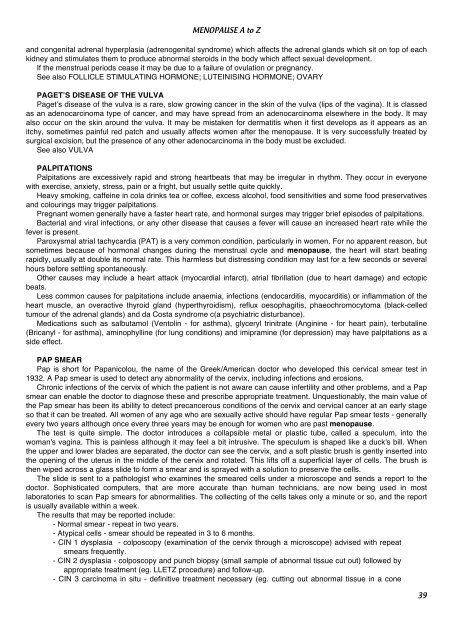Menopause A to Z.pdf - Medwords.com.au
Menopause A to Z.pdf - Medwords.com.au
Menopause A to Z.pdf - Medwords.com.au
You also want an ePaper? Increase the reach of your titles
YUMPU automatically turns print PDFs into web optimized ePapers that Google loves.
MENOPAUSE A <strong>to</strong> Z<br />
and congenital adrenal hyperplasia (adrenogenital syndrome) which affects the adrenal glands which sit on <strong>to</strong>p of each<br />
kidney and stimulates them <strong>to</strong> produce abnormal steroids in the body which affect sexual development.<br />
If the menstrual periods cease it may be due <strong>to</strong> a failure of ovulation or pregnancy.<br />
See also FOLLICLE STIMULATING HORMONE; LUTEINISING HORMONE; OVARY<br />
PAGET’S DISEASE OF THE VULVA<br />
Paget’s disease of the vulva is a rare, slow growing cancer in the skin of the vulva (lips of the vagina). It is classed<br />
as an adenocarcinoma type of cancer, and may have spread from an adenocarcinoma elsewhere in the body. It may<br />
also occur on the skin around the vulva. It may be mistaken for dermatitis when it first develops as it appears as an<br />
itchy, sometimes painful red patch and usually affects women after the menop<strong>au</strong>se. It is very successfully treated by<br />
surgical excision, but the presence of any other adenocarcinoma in the body must be excluded.<br />
See also VULVA<br />
PALPITATIONS<br />
Palpitations are excessively rapid and strong heartbeats that may be irregular in rhythm. They occur in everyone<br />
with exercise, anxiety, stress, pain or a fright, but usually settle quite quickly.<br />
Heavy smoking, caffeine in cola drinks tea or coffee, excess alcohol, food sensitivities and some food preservatives<br />
and colourings may trigger palpitations.<br />
Pregnant women generally have a faster heart rate, and hormonal surges may trigger brief episodes of palpitations.<br />
Bacterial and viral infections, or any other disease that c<strong>au</strong>ses a fever will c<strong>au</strong>se an increased heart rate while the<br />
fever is present.<br />
Paroxysmal atrial tachycardia (PAT) is a very <strong>com</strong>mon condition, particularly in women. For no apparent reason, but<br />
sometimes bec<strong>au</strong>se of hormonal changes during the menstrual cycle and menop<strong>au</strong>se, the heart will start beating<br />
rapidly, usually at double its normal rate. This harmless but distressing condition may last for a few seconds or several<br />
hours before settling spontaneously.<br />
Other c<strong>au</strong>ses may include a heart attack (myocardial infarct), atrial fibrillation (due <strong>to</strong> heart damage) and ec<strong>to</strong>pic<br />
beats.<br />
Less <strong>com</strong>mon c<strong>au</strong>ses for palpitations include anaemia, infections (endocarditis, myocarditis) or inflammation of the<br />
heart muscle, an overactive thyroid gland (hyperthyroidism), reflux oesophagitis, phaeochromocy<strong>to</strong>ma (black-celled<br />
tumour of the adrenal glands) and da Costa syndrome c(a psychiatric disturbance).<br />
Medications such as salbutamol (Ven<strong>to</strong>lin - for asthma), glyceryl trinitrate (Anginine - for heart pain), terbutaline<br />
(Bricanyl - for asthma), aminophylline (for lung conditions) and imipramine (for depression) may have palpitations as a<br />
side effect.<br />
PAP SMEAR<br />
Pap is short for Papanicolou, the name of the Greek/American doc<strong>to</strong>r who developed this cervical smear test in<br />
1932. A Pap smear is used <strong>to</strong> detect any abnormality of the cervix, including infections and erosions.<br />
Chronic infections of the cervix of which the patient is not aware can c<strong>au</strong>se infertility and other problems, and a Pap<br />
smear can enable the doc<strong>to</strong>r <strong>to</strong> diagnose these and prescribe appropriate treatment. Unquestionably, the main value of<br />
the Pap smear has been its ability <strong>to</strong> detect precancerous conditions of the cervix and cervical cancer at an early stage<br />
so that it can be treated. All women of any age who are sexually active should have regular Pap smear tests - generally<br />
every two years although once every three years may be enough for women who are past menop<strong>au</strong>se.<br />
The test is quite simple. The doc<strong>to</strong>r introduces a collapsible metal or plastic tube, called a speculum, in<strong>to</strong> the<br />
woman's vagina. This is painless although it may feel a bit intrusive. The speculum is shaped like a duck's bill. When<br />
the upper and lower blades are separated, the doc<strong>to</strong>r can see the cervix, and a soft plastic brush is gently inserted in<strong>to</strong><br />
the opening of the uterus in the middle of the cervix and rotated. This lifts off a superficial layer of cells. The brush is<br />
then wiped across a glass slide <strong>to</strong> form a smear and is sprayed with a solution <strong>to</strong> preserve the cells.<br />
The slide is sent <strong>to</strong> a pathologist who examines the smeared cells under a microscope and sends a report <strong>to</strong> the<br />
doc<strong>to</strong>r. Sophisticated <strong>com</strong>puters, that are more accurate than human technicians, are now being used in most<br />
labora<strong>to</strong>ries <strong>to</strong> scan Pap smears for abnormalities. The collecting of the cells takes only a minute or so, and the report<br />
is usually available within a week.<br />
The results that may be reported include:<br />
- Normal smear - repeat in two years.<br />
- Atypical cells - smear should be repeated in 3 <strong>to</strong> 6 months.<br />
- CIN 1 dysplasia - colposcopy (examination of the cervix through a microscope) advised with repeat<br />
smears frequently.<br />
- CIN 2 dysplasia - colposcopy and punch biopsy (small sample of abnormal tissue cut out) followed by<br />
appropriate treatment (eg. LLETZ procedure) and follow-up.<br />
- CIN 3 carcinoma in situ - definitive treatment necessary (eg. cutting out abnormal tissue in a cone<br />
39









